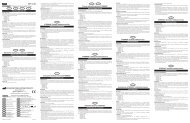® RMT THERMOCOOL ® Diagnostic/Ablation Steerable Tip Catheter
® RMT THERMOCOOL ® Diagnostic/Ablation Steerable Tip Catheter
® RMT THERMOCOOL ® Diagnostic/Ablation Steerable Tip Catheter
Create successful ePaper yourself
Turn your PDF publications into a flip-book with our unique Google optimized e-Paper software.
Instructions for Use NAVISTAR <strong>®</strong> <strong>RMT</strong> <strong>THERMOCOOL</strong> <strong>®</strong> <strong>Diagnostic</strong>/<strong>Ablation</strong> <strong>Steerable</strong> <strong>Tip</strong> <strong>Catheter</strong><br />
C.2 - Acute Procedural Success<br />
Acute procedural success results are presented in Table 19.<br />
Table 19 - Summary of Acute Procedural Success (Effectiveness Analysis Cohort, n = 226)<br />
Subset Description n Acute Success Percent (%) 95% C.I. 1<br />
Effectiveness Analysis Cohort 2,3 226 171 75.7 71<br />
Protocol Endpoint 75 65<br />
1 Exact binomial confidence bound.<br />
2 Data includes non-protocol catheter procedures considered a priori acute failures.<br />
3 Data includes subjects with incessant VT.<br />
The results from the acute outcome analysis based on termination of all clinical relevant VT upon hospital discharge<br />
demonstrate that the percentage of subjects achieving acute success (75.7%; 95% lower confidence bound of 71%) met<br />
the protocol endpoint for acute procedural success.<br />
C.3 - Chronic Success - Freedom from VT Recurrence at Six-Month Follow-Up<br />
Chronic success results are described in Table 20.<br />
Table 20 - Summary of Chronic Success (Effectiveness Analysis Cohort, n = 226)<br />
Subset Description n Chronic Success Percent (%) 95% C.I. 1<br />
Effectiveness Analysis Cohort 2,3 226 107 47.3 41.7<br />
Protocol Endpoint 50 40<br />
1<br />
Exact binomial confidence bound.<br />
2<br />
Data includes non-protocol catheter procedures considered a priori acute failures.<br />
3 Data includes subjects with incessant VT.<br />
The results demonstrate that the percentage of subjects achieving chronic success (47.3%, 95% lower confidence bound<br />
of 41.7%) met the protocol endpoint for chronic success. This is due to the fact that although the point estimate for<br />
chronic success was lower than the protocol endpoint, the 95% lower confidence bound of the estimate was higher than<br />
the protocol endpoint.<br />
Kaplan-Meier Analysis<br />
A Kaplan-Meier analysis was performed to estimate the time to VT recurrence. Standard errors were computed by the<br />
Peto method. The one hundred and seventy-one (171) subjects who achieved acute success were included in this<br />
analysis. Table 21 provides the number of subjects at risk (number of subjects entering the follow-up interval with acute<br />
success), number of subjects censored (number of subjects for whom the last follow-up exhibited freedom from<br />
recurrence of VT, at the time-point), number of events (subjects who experienced recurrence of VT), and the point and<br />
one-sided 95% C.I. estimation of VT recurrence-free probability. These numbers are defined at the exact time-point<br />
indicated, and do not necessarily correspond to the number of subjects followed with the follow-up windows. Figure 1<br />
provides the freedom from VT recurrence curve.<br />
Freedom from VT recurrence following acute success was 67.5% at 6 months.<br />
Table 21 - Kaplan-Meier Data Including the Nominal Interval, Number of Subjects at Risk, Number of Subjects<br />
Censored, and Number of Events, Point and One-sided 95% Confidence Interval Estimation of Recurrence-Free<br />
Probability Using Peto Method (Acute Success Subjects, n = 171)<br />
Nominal<br />
Interval<br />
No. of<br />
Subjects<br />
at Risk 1<br />
No. of<br />
Subjects<br />
Censored<br />
Cumulative Recurrence-Free Probability<br />
No. of<br />
Subjects<br />
with Events<br />
Point Estimate<br />
Peto Standard<br />
Error<br />
One-sided 95%<br />
Lower<br />
Confidence<br />
Limit (Peto)<br />
Day 0 171 0 0 1.0000 0.0000 1.0000<br />
Discharg<br />
e 2 164 0 8 0.9529 0.0162 0.9262<br />
3-weeks 3 145 2 24 0.8586 0.0268 0.8145<br />
1-month 143 3 25 0.8526 0.0274 0.8076<br />
2-months 132 3 36 0.7870 0.0316 0.7350<br />
3-months 124 3 45 0.7332 0.0343 0.6768<br />
4-months 115 8 48 0.7148 0.0356 0.6563<br />
5-months 107 14 52 0.6890 0.0379 0.6267<br />
6-months 54 64 54 0.6754 0.0534 0.5876<br />
1<br />
The number of subjects at risk is the number who did not have events or censoring before the time-point. If there are no<br />
events at a time-point, the total number of subjects in the analysis (171) equals the number at risk + the cumulative<br />
number censored + the cumulative number of events. This equation holds except at discharge, 3-months, 5-months, and<br />
6-months. There are an event exactly at discharge, an event at 3-months, an event and a censoring at 5-months, and a<br />
censoring at 6-months.<br />
16 M-5276-459C



